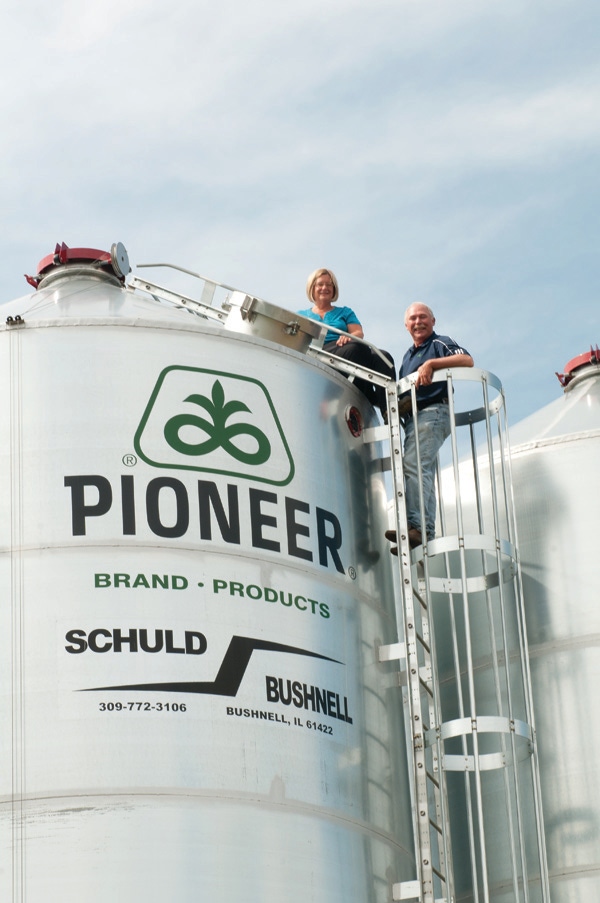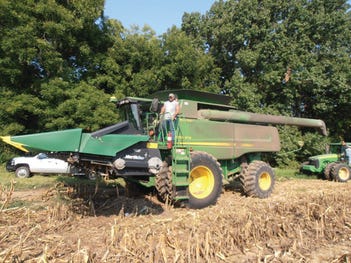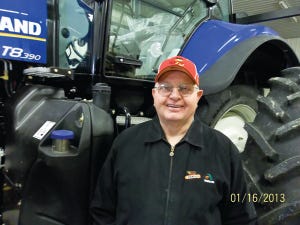March 1, 2013

Want to achieve award-winning corn yields? You might find a successful strategy by looking over the equipment and input lists used by winners of the 2012 National Corn Yield Contest. Farm Industry News interviewed six of these growers to uncover tips on inputs and equipment that helped these champs reap their bin-busting yields.
These six growers are among only 18 growers who earned national recognition by placing first, second or third in six production categories among 8,262 entries in the National Corn Growers Association (NCGA) contest. They recorded yields that more than doubled USDA’s projected 122.3 bu./acre national average for 2012.
Robert and Kathy Little, Hebron, Ind.
 Robert and Kathy Little both placed first in separate categories. Robert took first place in the AA no-till/strip-till nonirrigated category with a yield of 297.12 bu./acre. Kathy won first place in the AA nonirrigated category with a yield of 294.76 bu./acre.
Robert and Kathy Little both placed first in separate categories. Robert took first place in the AA no-till/strip-till nonirrigated category with a yield of 297.12 bu./acre. Kathy won first place in the AA nonirrigated category with a yield of 294.76 bu./acre.
Robert planted his no-till contest plot at 39,500 seeds/acre in 30-in. spacings. “I try to be very meticulous about planting,” says Robert, who manages the farm’s primary day-to-day field operations. “Speed-wise, I can tell from my monitor when I’m at the sweet spot, between 3½ and 4 mph. I also make sure the fields are dry enough to plant.”
The farm’s contest acres are sandy loam, “black sand” soils. “This is river-bottom, flat ground that drains pretty well,” Robert says.
Weed control is also a major emphasis. “On our farm, the hard-to-control weeds are waterhemp, lambsquarters, fall panicum, shattercane and velvetleaf,” he says. “We plan for a two-trip weed control application — one pre and one post.”
In 2012, the Littles hired an airplane to spray a fungicide, insecticide and a stress-reducing yield enhancer before tasseling. At about 10 days after tasseling, they hired another airplane to make a second fungicide and yield enhancer application.
What they bought:
Seed – Robert Little
Pioneer hybrid P1339XR
Seed - Kathy Little
Pioneer hybrid P1339XR
Fertilizer
300 lbs./acre of liquid 8-18-6-6S starter fertilizer
1 qt./acre zinc
½ pt./acre Stoller Bio-Forge and ½ pt./acre Stoller X-Tra Power
Crop protection
Bayer CropScience Defcon 2.1 granular insecticide in-furrow
1 qt./acre Buccaneer (glyphosate) burndown from Tenkoz, Inc.
2½ qt./acre DuPont’s Cinch ATZ preemergence herbicide with 15 gal./acre of 28% liquid N
1 qt./acre Buccaneer, 3 oz./acre BASF Status postemergence herbicide
200 units/acre N side-dressed in anhydrous ammonia form
10 oz./acre BASF Headline Amp, ¼ pt./acre Stoller BioForge, 1 pt./acre Dow AgroSciences Lorsban insecticide prior to tasseling
6 oz./acre BASF Headline and 1/4 pt./acre Stoller BioForge after tasseling
Tillage
Case IH subsoiler (on minimum-till acres)
Hurricane ditcher
Planter
John Deere 7200 planter
Precision Planting finger pickup units
20/20 SeedSense Precision Planting monitor system
Yetter residue managers
Sprayer
Hagie self-propelled STS10 sprayer
Combine
Case IH 2577 combine, Case IH roundbar concave
Woodburn Farm, Somerville, Tenn.
 Woodburn Farm registered the highest yield in NCGA’s four nonirrigated contest categories with a yield of 334.95 bu./acre. This was the farm’s first year entering the contest.
Woodburn Farm registered the highest yield in NCGA’s four nonirrigated contest categories with a yield of 334.95 bu./acre. This was the farm’s first year entering the contest.
Last year, the Rheas no-till planted corn on some acres, but they relied on conventional tillage for their contest acres, which were located on river-basin soils. “We always push this bottom ground for top-end yield,” says Scott Rhea, who farms with his dad, Rube, and brother, Matt. “We also like to create a raised seedbed to elevate the seed at planting for early-season rains.” The contest acres were planted March 21.
Rhea credits weed control and crop rotation for much of their success. “Our main weed concern right now is glyphosate-resistant Palmer pigweed,” he says. “We scout and use machetes and back-pack sprayers to chop it down and kill it during the season.”
They also broadcast half the labeled atrazine rate at planting and the other half with a full rate of Roundup and a full rate of Expert herbicide as a postemergence application.
What they bought:
Seed
DeKalb hybrid DKC64-69
Fertilizer
100-100-140 dry preplant fertilizer; 10 lbs./acre sulfur, 8 lbs./acre zinc, and 1 lb./acre boron
200 to 220 units of ammonia nitrate, side-dressed
Crop protection
FMC Corp. Mustang pyrethroid insecticide at planting
Monsanto Roundup and Valent Valor preplant herbicides
½ rate Syngenta atrazine at planting with sprayer attachment, TK-3 FloodJet spray tips
½ rate Syngenta atrazine with full rate of Monsanto Roundup and Syngenta Expert herbicides postemergence
Tillage
John Deere 900 V-Ripper, John Deere 980 field cultivator and soil crumbler, Brandt Hipper Roller
McFarlane reel disk and a John Deere 637 tandem disk with a soil crumbler
Planter
John Deere 1720 stack-fold planter (30 in., 16 rows), XP row units
Keeton seed firmers
Sprayer
John Deere 4830 self-propelled sprayer, 100-ft. boom
Machetes and back-pack sprayers
Combine
John Deere 9770 STS combine
Geringhoff NorthStar Elite corn header
Kip Cullers, Purdy, Mo.
 Kip Cullers placed third in the no-till/strip-till irrigated category with a yield of 322.71 bu./acre. “It was the best hybrid we had last year,” Cullers says. “We averaged about 300 bu./acre with it on all our farms. On our contest plot, it averaged 321 bu./acre for the whole 50-acre field.”
Kip Cullers placed third in the no-till/strip-till irrigated category with a yield of 322.71 bu./acre. “It was the best hybrid we had last year,” Cullers says. “We averaged about 300 bu./acre with it on all our farms. On our contest plot, it averaged 321 bu./acre for the whole 50-acre field.”
Cullers says that he selects corn hybrids for contest fields by closely examining his DuPont Pioneer IMPACT (Intensively Managed Product Advancement Characterization and Training) trials and research plots for top-performing hybrids. Other than his hybrid selection in 2012, “the only thing we did different last year was use DuPont’s Coragen insecticide to control earworms,” Cullers says. “We applied it with our first application of Headline Amp fungicide (at 6-oz. rate) at silking (V12).”
Prior to planting, Cullers applied two tons/acre of chicken litter. At planting, he applied Bicep II Magnum and Kixor preemergence herbicides, using a high-clearance sprayer. “We scout almost every day,” Cullers says. “The Kixor was effective throughout the growing season.”
What they bought:
Seed
Pioneer hybrid P2088HR
Fertilizer
2 tons/acre of chicken litter
Crop protection
1.5 qt./acre of Syngenta Bicep II Magnum herbicide at planting
Labeled rate of BASF Kixor herbicide at planting
BASF Headline Amp fungicide (at 6-oz. rate) at silking, DuPont Coragen insecticide
Labeled rate of Stoller BioForge root promoter at the V4 or V5 growth stage with Monsanto Roundup postemergence herbicide
Planter
John Deere 1770 central-fill, no-till planter
Sprayer
RoGator self-propelled, high-clearance sprayer
Combine
John Deere 9770 STS combine
David Oberbroeckling, Davenport, Iowa
 David Oberbroeckling placed second nationally in the AA no-till/strip-till nonirrigated category with a yield of 284.41 bu./acre.
David Oberbroeckling placed second nationally in the AA no-till/strip-till nonirrigated category with a yield of 284.41 bu./acre.
“There is no single production decision that is more important than any other,” says Oberbroeckling, a multiple state and national yield contest winner. “They’re all important.”
Still, Oberbroeckling cites scouting often and taking care of weeds as critical factors in addition to hybrid selection. Fertile soils and timely rains also helped him reach high yields.
Oberbroeckling planted on April 23 at 35,500 seeds/acre. He also credits GPS-guided machinery for helping him obtain high yields. “Precision farming equipment gives us uniform application,” he states. “It makes a big difference in anhydrous ammonia application and eliminates product overlap and skips.”
Oberbroeckling harvested his contest plot Sept. 24 at 19.6% moisture using a Geringhoff rotor disc head.
What they bought:
Seed
DeKalb hybrid DKC62-09
Fertilizer
140 units per acre fall-applied N, with anhydrous ammonia
Dry-applied 65 units P and 75 units K per acre with 20 lbs. sulfur and 1.5 lbs. zinc
Chandler dry seed treatment
Crop protection
6.2 oz./acre Bayer CropScience Corvus preemergence herbicide, l.5 lbs./acre atrazine, 6 oz./acre Agri-SC soil treatment, from Four Star Services, Inc., 50 units of 32% N/acre one day after planting
Monsanto Roundup postemergence herbicide
2.5 oz. Bayer CropScience Stratego fungicide at 5th leaf stage
Planter
Case IH 1250 planter with row clutches
Case IH autosteer equipment
Martin floating row cleaners
Case IH AFS Pro 700 display monitor
Iowa Department of Transportation RTK GPS signal
Sprayer
Hardi pull-type sprayer
Combine
Case IH 7010 combine
Geringhoff rotor disc corn head
Jamie Gorder, Wahpeton, N.D.
Jamie Gorder placed 2nd nationally in the nonirrigated category with a yield of 298.62 bu./acre. She planted her contest plot on April 26 at a 40,000/acre seed rate on former sugar beet ground. “We selected the right variety for the year we had,�” she says. “It was 100-day maturity; we normally plant 95-day maturities.
“We plant on ridges that we make the previous fall,” reports Gorder, who farms with her husband, Mark, and son, Vincent. “It’s very flat ground with hardly any slope. The ridges help to warm up the ground and keep the seed from sitting in too much moisture.”
Much of the equipment used on the farm is homemade. “Our son made our ridger,” she says. “He rebuilt an old toolbar and put it together with a cotton lister that he’d bought from Texas. He also adapted a stalk puller made for cotton equipment that we could use for corn after corn.”
In addition, her son created the starter- and foliar-fertilizer mixtures that the farm uses. “This year we put down our own (starter) fertilizer concoction that included a root stimulant,” she explains. “It’s kind of our own magic elixir. We also foliar feed our own concoction three times at various growth stages before full maturity as we’re doing weed control.”
What they bought:
Seed
Pioneer hybrid P0062XR
Fertilizer
Spring-applied dry, 100-60-60 NPK preplant fertilizer along ridge
Homemade starter fertilizer concoction with root stimulator
Home-concocted foliar fertilizer
100 lbs./acre liquid nitrogen side-dress applied
Fertilizer drop nozzles
Crop protection
Volley preemergence corn herbicide, from Tenkoz, Inc., banded with the planter
Bayer CropScience Buctril postemergence herbicide, sprayed on 8-in.-tall corn
Arysta LifeScience Evito fungicide applied at brown silk
Tillage
Homemade ridger for making raised seedbeds
Modified cornstalk puller
Planter
12-row, 30-in. John Deere 1710 integral vertical fold planter
Cultivator
Homemade row cultivator
Combine
John Deere 9770 STS combine
About the Author(s)
You May Also Like




